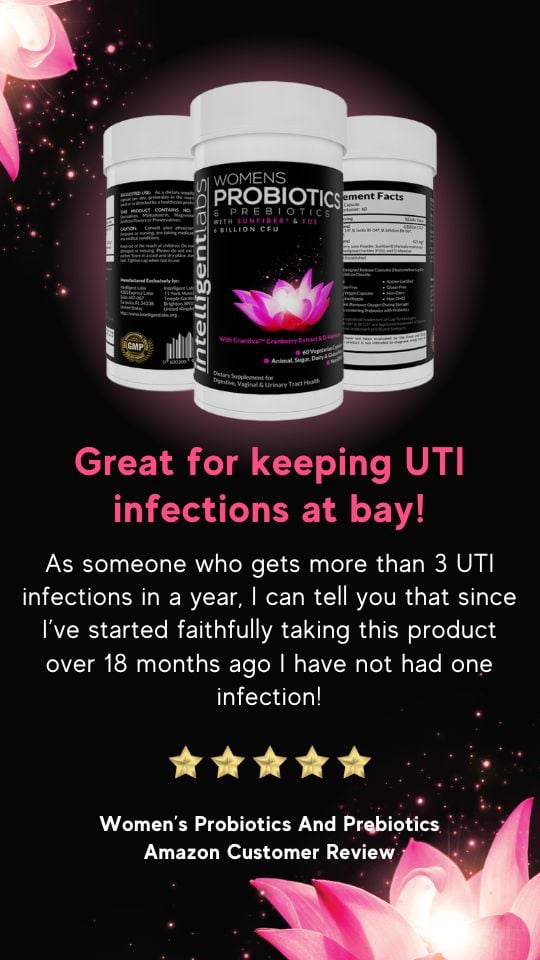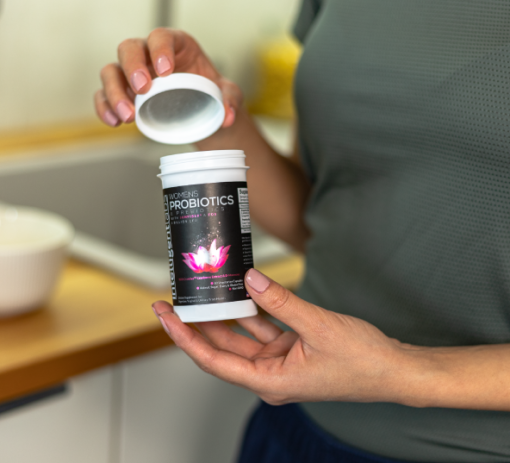Warum sollten Frauen weibliche Probiotika anstelle von herkömmlichen einnehmen?
Choosing feminine live cultures over regular ones is important for women. You might ask, “Aren’t all live cultures similar?” Not quite. As you’ll see below, a product specifically designed for women, like our Women’s Live Cultures & Fibre, may boost feminine health in ways that generic live cultures might not.
What’s so special about feminine live cultures? How do they help women?
So, let’s start with the basics: live cultures are good bacteria that contribute to many aspects of our health, including gut and immune health, and yes, also feminine health.
In our Ultimate Guide To Live Cultures, we shared more than 20 health benefits. But in this blog post, we’ll focus on the women-specific benefits. Here are some of them:
1) Women’s live cultures may support vaginal health
The key to vaginal health is maintaining a balance of microorganisms (both good and bad) in the vagina. The predominant beneficial bacteria is called Lactobacillus.
Lactobacilli increase lactic acid levels and make the vaginal environment more acidic. This acidity is a natural defense, deterring harmful bacteria and enhancing protection against infections, thereby bolstering vaginal health.1
Our Women’s Live Cultures contain a blend of Lactobacillus and Bifidobacterium strains that may help maintain this balance, reducing the risk of yeast infections and bacterial vaginosis.
2) Feminine live cultures may prevent urinary tract infections
Urinary tract infections (UTIs) range from being a minor annoyance to causing severe pain. These infections develop when bacteria grow in the urinary tract, leading to inflammation.

Women are more susceptible to UTIs than men due to their shorter urethra. Estimates suggest about 50% of women will experience a UTI at some point, and up to 23.9% of pregnant women get an infection.2
The good news is that women’s live cultures may offer a preventive solution by warding off harmful bacteria. One study found that taking live cultures for UTI may help prevent the infection from coming back. 3
While antibiotics are a standard treatment, they eliminate both beneficial and harmful bacteria, which can lead to issues like antibiotic resistance if not taken as prescribed. This resistance can make future infections harder to treat.
However, live cultures target only harmful bacteria and have been shown not to contribute to antibiotic resistance, offering a promising alternative for managing UTIs.4
For even better UTI action, we’ve enriched our Women’s Live Cultures with Cranberry and D-Mannose powders. Both ingredients are known for their potential to prevent urinary tract infections (UTIs).
Cranberry powder helps flush out harmful microorganisms from the urinary tract by preventing bacteria from adhering to the lining, thus reducing UTI risk. 5 6 Meanwhile, D-mannose is a promising antibiotic alternative, potentially clearing the bacteria that cause UTIs and preventing their recurrence.7 8
3) Women’s live cultures may help with hormone balance and bone health
Lower estrogen levels after menopause lead to postmenopausal osteoporosis (PMO), resulting in weakened bones and a higher risk of fractures for women.9
Traditional treatments for PMO carry substantial side effects, including an increased risk of cancer. Fortunately, live cultures may be a safer alternative.
Recent studies linking gut health to bone strength have shown that live cultures can help balance hormones that affect bone health in postmenopausal women. 10 11
4) Live cultures may help women maintain a healthy weight
Research suggests that live cultures could be beneficial for women’s weight management and metabolic health.
Specific strains of Lactobacillus and Bifidobacterium have been shown to reduce body weight, BMI, and fat mass by altering gut microbiota composition. These effects are strain-specific and appear to vary between genders, often offering more substantial benefits to women.12 13
Moreover, adding live cultures to a weight loss diet led to more significant improvements in heart health than just dieting alone.14
5) Live cultures for women may help manage PCOS symptoms
Polycystic ovary syndrome (PCOS) affects many women of reproductive age, and its symptoms can be exacerbated by being overweight. However, taking live cultures for weight loss, alongside a healthy lifestyle, could offer benefits.
Research by Calcaterra et al. suggests a link between PCOS, obesity, and gut bacteria imbalance, particularly in teenage girls. Their findings indicate that live cultures could aid in balancing hormones, reducing inflammation, and boosting metabolism in teens with PCOS.
Participants who took live cultures experienced better weight, blood sugar levels, and body mass index (BMI). Although further studies are necessary, live cultures are a promising PCOS supplement for managing this condition in overweight individuals.15
6) Female live cultures may even help slow cervical cancer
Cervical cancer is the fourth most common cancer among women worldwide. Early detection and vaccination are cost-effective ways to prevent it. If caught early and treated promptly, cervical cancer can also be cured. 16
Interestingly, there’s a 2022 study that highlights the potential of a healthy vaginal microbiome to slow the progression of cervical cancer.
So, as mentioned in point #1, live cultures contribute to a healthy vagina. They help strengthen the vaginal mucosal barrier and limit the attachment of harmful flora to the barrier. This amplifies the immune system’s capacity to combat threats in the vagina, including directly attacking cancer cells.
But that’s not all! The same study also reported that live cultures may reduce the side effects of radiotherapy. This makes live cultures a promising supplementary strategy in cervical cancer management. 17
So, what is the best live cultures supplement for women?
Now, what makes the Intelligent Labs Women’s Live Cultures & Fibre stand out? Well, our formula isn’t just any live culture blend; it’s specifically tailored to meet the unique health needs of women.

Our product features 4 patented strains selected for their positive impact on women’s health, ensuring you receive targeted support. These strains are L. acidophilus La-14®, B. lactis Bl-04®, B. bifidum Bb-06®, and B. longum Bl-05®.
Like our other Live Cultures & Fibre supplements, we’ve also included two types of fibre (Sunfiber® and FOS) in our feminine live cultures. The fibres nourish these live cultures, enhancing their effectiveness in your gut.
And, as mentioned in benefit #2, our formula also includes a healthy dose of Cranberry powder and D-mannose powder for additional feminine support!
Related article: How To Choose The Best Live Cultures For Women?
Conclusion
Supplementing with feminine live cultures like our Women’s Live Cultures & Fibre is a small change that can make a big difference in your health. Whether it’s supporting your vaginal health, helping prevent those pesky UTIs, or just giving your gut that extra bit of love, our product is designed with your well-being in mind!
💬 Something on your mind? Share your thoughts in the comments. We love hearing from curious minds.
📩 And while you’re here, join our newsletter for more smart stuff (and secret perks)!
References:
- O’Hanlon, Deirdre E., et al. „Vaginaler pH-Wert und mikrobizide Milchsäure, wenn Laktobazillen die Mikrobiota dominieren.“ PLoS ONE, Bd. 8, Nr. 11, 6. November 2013, S. e80074, www.ncbi.nlm.nih.gov/pmc/articles/PMC3819307/ ↩︎
- Nahid Ebadi Salari et al. „Globale Prävalenz von Harnwegsinfektionen bei schwangeren Müttern: Eine systematische Überprüfung und Metaanalyse.“ Public Health, Bd. 224, 1. November 2023, S. 58–65, https://doi.org/10.1016/j.puhe.2023.08.016 ↩︎
- Amanda Chan. „Probiotika könnten helfen, Harnwegsinfektionen vorzubeugen.“ Livescience.com, 15. April 2011, www.livescience.com/13747-good-bacteria-prevent-urinary-tract-infection.html. ↩︎
- Beerepoot, Mari[[euml]]lle A. J. “Lactobacilli vs Antibiotics to Prevent Urinary Tract Infections.” Archives of Internal Medicine, vol. 172, no. 9, 14 May 2012, p. 704, https://doi.org/10.1001/archinternmed.2012.777. ↩︎
- González de Llano, Dolores, et al. „Cranberry-Polyphenole und die Vorbeugung von Harnwegsinfektionen: Relevante Überlegungen.“ Molecules, Bd. 25, Nr. 15, 1. August 2020, S. 3523, https://doi.org/10.3390/molecules25153523. ↩︎
- Shin, Cha-Nam. „Die Wirkung von Cranberries auf die Vorbeugung von Harnwegsinfektionen.“ Clinical Nursing Research, Bd. 23, Nr. 1, 8. Februar 2013, S. 54–79, https://doi.org/10.1177/1054773813475448. ↩︎
- Wagenlehner, Florian, et al. „Warum D-Mannose bei der Behandlung akuter unkomplizierter Infektionen der unteren Harnwege genauso wirksam sein kann wie Antibiotika – Vorüberlegungen und Schlussfolgerungen aus einer nicht-interventionellen Studie.“ Antibiotics, Bd. 11, Nr. 3, 25. Februar 2022, S. 314, https://doi.org/10.3390/antibiotics11030314. ↩︎
- Kranjčec, Bojana, et al. „D-Mannose-Pulver zur Prophylaxe wiederkehrender Harnwegsinfektionen bei Frauen: Eine randomisierte klinische Studie.“ World Journal of Urology, Bd. 32, Nr. 1, 2014, S. 79–84, https://doi.org/10.1007/s00345-013-1091-6. ↩︎
- Eastell, Richard, et al. „Postmenopausale Osteoporose“. Nature Reviews Disease Primers, Bd. 2, Nr. 1, 29. September 2016, https://doi.org/10.1038/nrdp.2016.69 ↩︎
- Huidrom, Sangeeta, et al. „Postmenopausale Osteoporose und Probiotika.“ Current Drug Targets, Bd. 21, 27. Oktober 2020, https://doi.org/10.2174/1389450121666201027124947. ↩︎
- Britton, Robert A., et al. “ProbioticL. ReuteriTreatment Prevents Bone Loss in a Menopausal Ovariectomized Mouse Model.” Journal of Cellular Physiology, vol. 229, no. 11, 29 July 2014, pp. 1822–1830, https://doi.org/10.1002/jcp.24636. ↩︎
- Sanchez, Marina, et al. „Wirkung der Nahrungsergänzung mit Lactobacillus Rhamnosus CGMCC1.3724 auf Gewichtsverlust und Gewichtserhaltung bei übergewichtigen Männern und Frauen.“ British Journal of Nutrition, Bd. 111, Nr. 8, 3. Dezember 2013, S. 1507–1519, https://doi.org/10.1017/s0007114513003875 ↩︎
- Kadooka, Y, et al. „Regulierung der abdominalen Adipositas durch Probiotika (Lactobacillus Gasseri SBT2055) bei Erwachsenen mit Tendenz zur Fettleibigkeit in einer randomisierten kontrollierten Studie.“ European Journal of Clinical Nutrition, Bd. 64, Nr. 6, 10. März 2010, S. 636–643, https://doi.org/10.1038/ejcn.2010.19. ↩︎
- Moludi, Jalal, et al. „Interaktive Wirkung von Probiotika-Supplementierung und Diät zur Gewichtsreduktion auf Merkmale des metabolischen Syndroms bei Patienten mit koronarer Herzkrankheit: Eine doppelblinde, placebokontrollierte, randomisierte klinische Studie.“ American Journal of Lifestyle Medicine, 3. Mai 2019, S. 155982761984383, https://doi.org/10.1177/1559827619843833. ↩︎
- Calcaterra, Valeria, et al. „Probiotika und polyzystisches Ovarialsyndrom: Eine Perspektive für die Behandlung von Jugendlichen mit Adipositas.“ Nutrients, Bd. 15, Nr. 14, 14. Juli 2023, S. 3144–3144, https://doi.org/10.3390/nu15143144. ↩︎
- Weltgesundheitsorganisation. „Gebärmutterhalskrebs.“ Weltgesundheitsorganisation, Weltgesundheitsorganisation, 17. November 2023, www.who.int/news-room/fact-sheets/detail/cervical-cancer. ↩︎
- Mei, Zhaojun, and Dandan Li. “The Role of Probiotics in Vaginal Health.” Frontiers in Cellular and Infection Microbiology, vol. 12, 28 July 2022, https://doi.org/10.3389/fcimb.2022.963868. ↩︎







